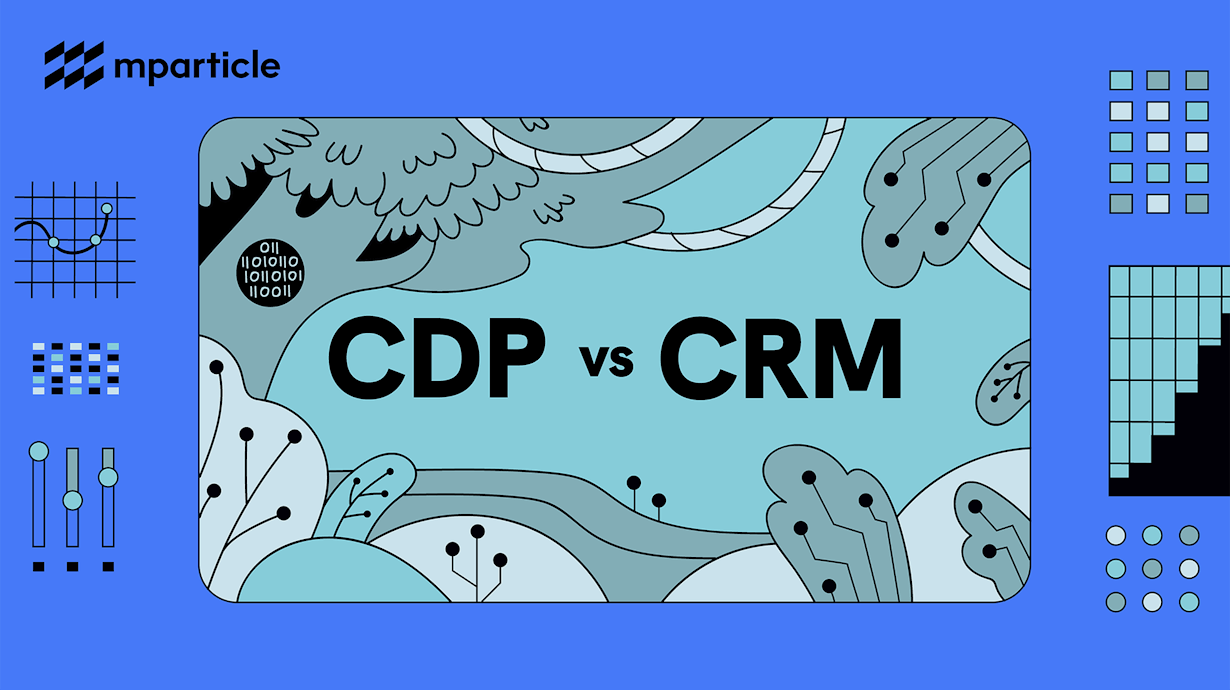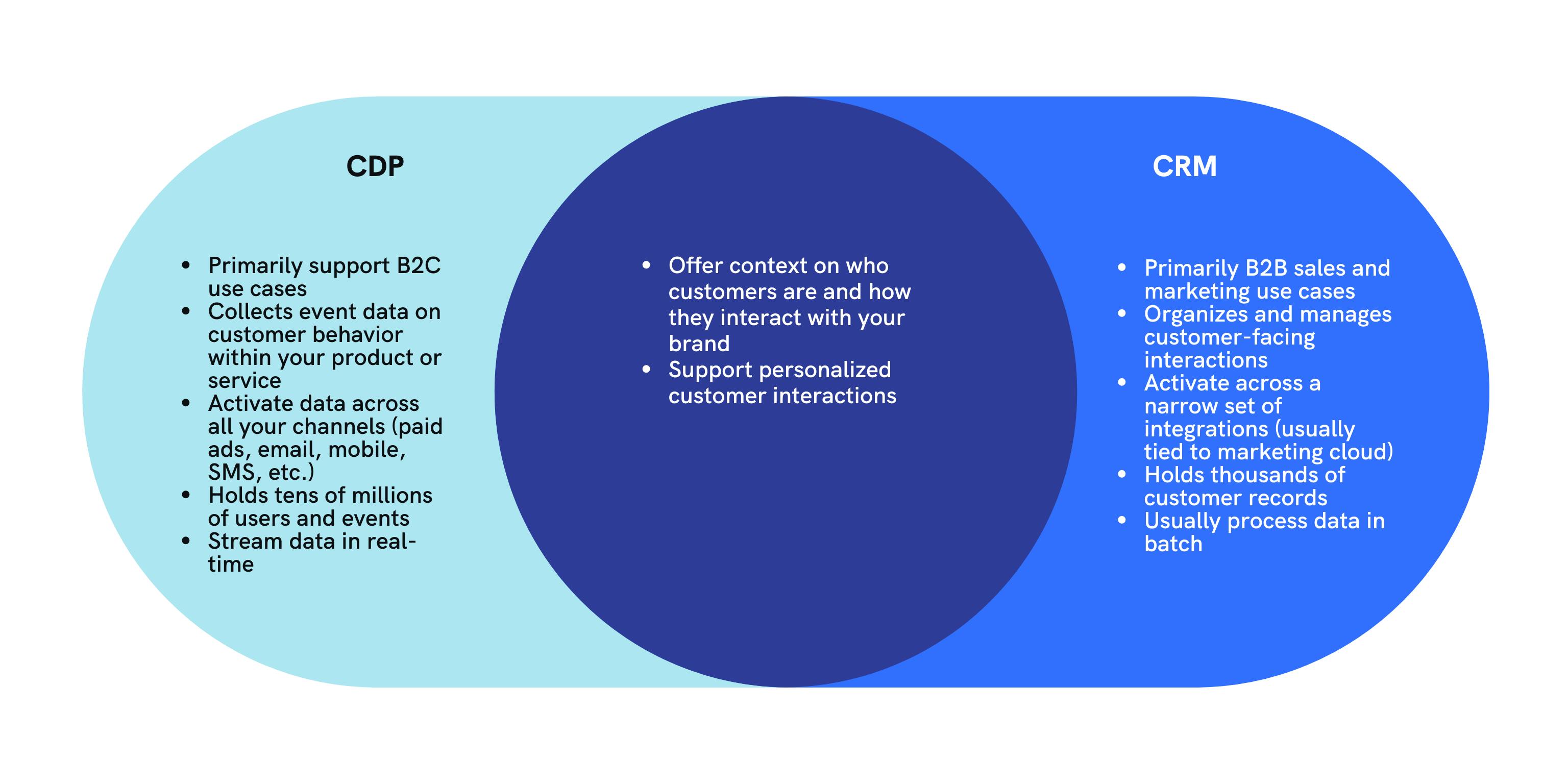CDP vs. CRM: What’s the difference, and is CDP the new CRM?
Customer Data Platforms (CDPs) and Customer Relationship Management (CRM) tools are often confused, as both store customer records that the business can use for insight. Below the surface, however, they're very different solutions. This article breaks down the distinction and explores whether or not CDPs and CRMs can fruitfully coexist in the same technology stack.

In today’s market, companies that most effectively collect, harness, and activate customer data have a huge advantage over their less data-informed competitors.
The challenge is to build the right customer data stack—one that weaves together best-in-class data, analytics, and activation tools, while breaking down silos and ensuring everyone on the team has access to accurate, holistic, and privacy-compliant data.
Most marketers we work with have used a Customer Relationship Management (CRM) tool. But evolving consumer expectations around personalization, customer experience, and data privacy have led many teams to look for a more powerful solution to serve as their foundational customer data layer.
In this exploration, many have questioned the difference between a CRM and a Customer Data Platform (CDP), unclear about which one is better suited to their customer data needs.
To help you better understand the difference and figure out which solution is right for you (spoiler alert: it may be both), this article discusses:
- How both CDPs and CRMs work
- The key differences between them
- How they can work together to help you turn customer data into your competitive advantage
What is a CRM and what can it do?
Though many refer to the whole field of customer relationship management as “CRM,” for our purposes here, we’re talking about CRM software (like Salesforce, HubSpot, and Pipedrive).
As Salesforce defines it, CRM software is “a technology for managing all your company’s relationships and interactions with customers and potential customers. [...] a tool that helps with contact management, sales management, agent productivity, and more.”
CRMs take in data around one-on-one interactions between your business and your customers. Data from things like sales calls, support tickets and emails, demo notes, and even contracts gets stored in your CRM and helps inform future touchpoints with that customer.
Traditionally, CRMs were used primarily by B2B marketers and a small subset of B2C brands (catalog retailers, loyalty programs, and the like). Today, everyone from consumer packaged goods (CPGs) to post-cable networks to coffee chains needs to focus on prioritizing the customer experience and building long-term relationships with customers.
That’s why many marketers, sales reps, and even support pros now see the CRM as their source of truth for customer profiles and data activation/campaign delivery for email and messaging channels.
From there, CRM data typically stays within a small ecosystem of marketing and sales tools.
The data you need, where and when you need it
There’s no doubt CRMs have their place in the marketing and sales world. But the reality is that the typical CRM isn’t equipped to support the customer data infrastructure needs of modern consumer brands.
Across every consumer category, the path to purchase has become multi-threaded, involving smartphones, voice assistants, and connected TVs, among other channels. Each touchpoint leaves a trail of customer data that, when properly leveraged, can be used to improve future interactions.
Today’s consumers (both B2B and B2C) expect brands to deliver highly personalized, relevant customer experiences.
The modern customer experience traverses across channels and devices, meets consumers where they are, and remains a priority well beyond the acquisition—helping to engage existing customers, improve retention and LTV, and more.
Optimizing for that requires access to all customer data—from sales to marketing to product and support—and the ability to activate that data across channels in a coordinated way. Much of that data has historically been siloed across multiple departments and platforms. That makes it hard to:
- Form a holistic picture of customers
- Personalize CX in real-time
- Operationalize customer profiles across all your downstream tools
Traditional CRMs don’t help the problem because they only collect data from one-to-one interactions—and forward it on to a limited number of other tools. They’re built to serve as a record of one-to-one touchpoints between your team and a customer. Plus, CRMs draw on historical data, so you can’t use the software to power real-time messaging and personalization.
Customer Data Platforms, on the other hand, help you build comprehensive customer profiles that can be used across the company, in real-time.
What is a CDP and how is it different from a CRM?
CDPs provide marketers with a single platform with which to ingest, manage, transform, and connect all customer data, regardless of the source.
When it comes to CDP versus CRM, here’s the big difference: a CRM organizes and manages customer-facing interactions with your team, while CDPs collect data on customer behavior within your product or service and make it easier to connect that data to additional third-party systems.
CDPs focus on collecting customer data to power analytics and personalization such as user identifiers, behavioral events, consent state.
Multi-threaded customer journeys
Customer journey analytics are a prominent value of CDPs, as CDPs enable marketers, product teams, and more to build a holistic understanding of how consumers become customers and how users move through your website, app, and other digital products.
Whereas CRMs only collect data from direct, one-to-one interactions between your company and a customer or prospect, CDPs collect data from every touchpoint and every step along the journey.
With customer data available in a CDP, you can build multi-threaded customer journeys that:
- Encompass touchpoints across every device, channel, and over time
- Include data from throughout the customer journey
- Power individualized personalization
With customer and event data that uncovers the full customer journey, you can better understand:
- How conversions happen
- Which campaigns contribute to acquisition and where to allocate spend
- The behaviors and usage patterns that correlate with retention and high lifetime value (LTV)
Data that’s open and accessible to downstream tools
Open accessibility to your customer data is one of the key benefits of implementing a CDP. Using a CDP, you can create customer profiles and segments once, then pipe them into all your downstream activation tools like:
- Ad and consumer marketing platforms like Google Ads and Facebook
- Email, push, and SMS marketing tools like Marketo or Mailchimp
- Data warehousing solutions such as Snowflake or Google BigQuery
- Personalization and real-time marketing software
- Customer service and chat solutions
- And, yes, your CRM
That means you can collect and synthesize data once, then put it to work across the rest of your stack. Pre-built integrations often make this process super quick, with minimal bandwidth required from the data team. It also means you can eliminate silos, ensuring every team can access the full potential of your customer and event data.
See what’s possible by exploring our integration use case library.
Customer data at scale
CDPs are built to collect, process, and stream data at scale. That includes tracking engagement activity for millions of users (including anonymous users, for whom you don’t have any associated PII) and tens of millions of events.
That’s a big step up from a CRM, which is built to handle—at most—data in the range of tens of thousands of customers. That’s another reason why CDPs are better suited for large B2C brands (like Spotify or Airbnb, for example) that serve millions of users.
Speed is a big factor here, too: CDPs are built to stream data at rates as fast as tens or hundreds of thousands of hits per second, while solving for things like identity resolution and privacy in real time.
CRMs aren’t built for that. They use more infrequent batching because the use cases they’re designed for didn’t require real-time data.
Data at scale enables more customer profiles, a more detailed view of the customer journey, more granular analytics, and more expansive and impactful marketing campaigns.

Both—not either/or
Much of the confusion centers around the view of CDPs as a competitor to CRMs, with many heralding the CDP as a replacement—the new CRM. In reality, the two systems work together. A CDP sits upstream of your CRM and often forwards data to the CRM to support experiences such as personalized email and triggered messaging.
If you already use a CRM, adding a CDP as the foundational layer in your data stack can help enrich your CRM data and make it more valuable for sales and marketing teams.




